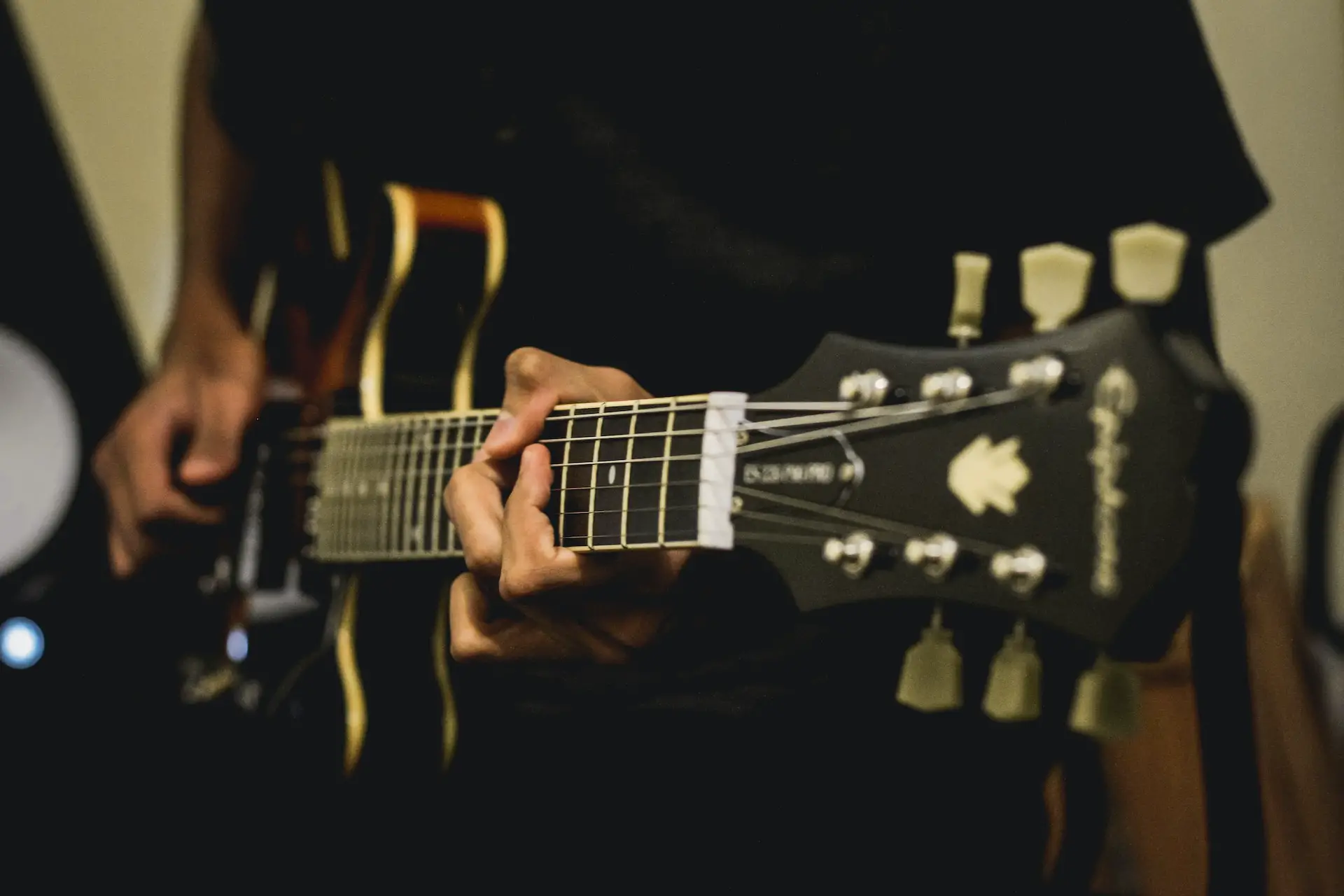It is necessary to learn barre chords if you want to expand your playing abilities on the guitar. Barre chords are versatile and widely used in various genres of music. By learning them, you gain the ability to play chords all over the neck of the guitar, allowing for greater range and flexibility in your playing.
Barre chords, also known as movable chords, are formed by using one finger to hold down multiple strings across the guitar neck. These chords are essential for playing complex chord progressions and can open up a whole new world of possibilities for your guitar playing.
One of the main benefits of learning barre chords is that they enable you to play chords in different keys without changing the chord shapes. This is especially useful when playing along with other musicians or when transposing songs. With barre chords, you can easily move a chord shape up or down the neck to play it in a different key.
Barre chords also allow you to play chords with different voicings and inversions. This means that you can create unique and different sounds by simply moving the same chord shape to a different position on the neck. This adds depth and variety to your playing and enhances your ability to express yourself musically.
Furthermore, barre chords are commonly used in playing lead guitar as well. By mastering barre chords, you will have a solid foundation for learning advanced techniques such as soloing, improvisation, and playing melodies on the higher strings.
While learning barre chords can be challenging, especially for beginners, it is a worthwhile investment of time and effort. With practice, you will gradually build strength and dexterity in your fingers, making it easier to play barre chords accurately and cleanly.
Here’s a summary that sums up the entire article if you are too busy. Otherwise, read till the end because there are much more to the topic!
| Topic | Summary |
|---|---|
| Is it necessary to learn barre chords? | Learning barre chords expands playing abilities, allows for playing chords in different keys, and creates unique voicings and inversions. |
| What happens if you can’t play barre chords? | Not being able to play barre chords can limit playing abilities, restrict playing in different keys, and hinder progress in advanced techniques. |
| Can you play guitar without barre chords? | Guitar can be played without barre chords using open chords and alternative chord shapes, but barre chords enhance flexibility and create unique sounds. |
| How long does it take to learn barre chords? | Learning barre chords can take a few weeks to a few months with consistent practice and dedication. |
| Why is barring chords so hard? | Barre chords can be difficult due to finger strength, coordination, technique, and mental obstacles. |
| Common challenges encountered when learning barre chords | Challenges include finger strength, finger fatigue, buzzing or muted strings, and achieving clean chord changes. |
| How can I improve my barre chord technique? | Tips include building finger strength, focusing on proper finger placement, practicing chord transitions, and using arm weight to aid pressure. |
| Are there any alternative chord shapes to barre chords? | Alternative shapes include partial barre chords, open voicings, power chords, double stops, and triads, offering different sounds and ease of playability. |
Also Read: Impact Of Finger Size To Guitar Playing: Is Skinny Better?
What happens if you can’t play barre chords?

Not knowing how to barre chords will hinder your development
If you can’t play barre chords, you may find yourself limited in your guitar playing abilities. Barre chords are a fundamental skill that opens up new possibilities for playing chords, transposing songs, and creating unique sounds. Without them, you may struggle to play certain songs or progressions that require barre chord shapes.
When you can’t play barre chords, you are limited to playing open chords, which are chords that use open strings and do not require barring across the neck. While open chords are important and widely used, they have limitations in terms of voicings and positions on the guitar neck. This means that certain songs or chord progressions may be difficult or impossible to play without barre chords.
Additionally, not being able to play barre chords can hinder your ability to play in different keys. Transposing songs to a different key becomes challenging without using barre chords, as you would need to find alternative chord shapes or use a capo. This can restrict your ability to play along with other musicians or perform certain songs in the desired key.
Furthermore, barre chords offer the opportunity to create different voicings and inversions of chords. This allows for more interesting and varied sounds in your playing. Without barre chords, you may miss out on the chance to explore new sonic possibilities and limit yourself to basic open chord positions.
Not being able to play barre chords can also impact your progress as a guitarist. Many advanced techniques, such as soloing, improvisation, and playing melodies on the higher strings, rely on a solid foundation of barre chords. Without this foundation, it may be challenging to master these techniques and progress further in your guitar playing journey.
That being said, it’s important to remember that learning barre chords can be difficult, especially for beginners. It requires strength and dexterity in your fingers, as well as practice and patience. If you’re struggling with barre chords, it’s important to seek guidance from a guitar teacher or explore resources such as online tutorials and exercises specifically designed to help improve your barre chord technique.
Also Read: Mastering Chord Changes: How Long & Tips To Get Better Fast
Can you play guitar without barre chords?
You can definitely play guitar without barre chords. There are plenty of songs and styles of music that can be played using open chords and alternative chord shapes. However, learning barre chords can significantly expand your playing abilities and open up new possibilities for your musical expression.
Playing guitar without barre chords primarily involves using open chords, which are chords that incorporate open strings and do not require barring across the neck. Open chords are the foundation of many popular songs and are widely used in various genres such as folk, pop, and country music. They provide a solid starting point for beginners and allow for creating simple chord progressions and accompaniment patterns.
With open chords, you can play a vast repertoire of songs and enjoy playing the guitar without incorporating the more complex technique of barre chords. Many iconic songs, both old and new, rely solely on open chords and still sound great.
However, it’s important to note that not learning barre chords limits your flexibility as a guitarist. Barre chords enable you to play in different keys and transpose songs easily without changing the chord shapes. They also allow for playing chords with different inversions and voicings, adding depth and variety to your playing. By only relying on open chords, you may struggle to recreate the exact sound and feel of certain songs or progressions that require barre chords.
Learning barre chords can also facilitate your growth as a musician. Many advanced techniques, such as soloing, improvisation, and playing complex melodies, are built upon a foundation of barre chords. By mastering barre chords, you gain a wider range of skills and open doors to explore different styles and genres of music.
How long does it take to learn barre chords?

With consistent practice, you can learn barre chords in a few weeks. It takes some time to build that finger strength.
The time it takes to learn barre chords can vary depending on various factors such as your prior experience, dedication to practice, and individual learning abilities. However, with consistent practice and proper technique, most people can start playing basic barre chords within a few weeks to a few months.
Learning barre chords requires developing strength and dexterity in your fingers to hold down multiple strings across the neck of the guitar. This can feel challenging at first, especially for beginners, as it involves applying pressure evenly across the strings. It may take some time for your fingers to build the necessary strength, coordination, and muscle memory to form barre chords accurately.
It’s important to approach learning barre chords with patience and a consistent practice routine. Dedicate regular practice time to focus specifically on barre chords and gradually increase the difficulty of the chord shapes as you progress. Start with simpler barre chord shapes, such as the F major or B minor, before moving on to more complex shapes.
There are various exercises and techniques you can practice to improve your barre chord skills. Suggested exercises include practicing barring across the neck and releasing tension in your hand, as well as transitioning smoothly between different barre chord shapes. Incorporating these exercises into your practice routine will help strengthen your fingers and improve your technique.
Additionally, it can be helpful to seek guidance from a guitar teacher or utilize online tutorials and resources specifically tailored to learning barre chords. They can provide valuable tips, techniques, and exercises to break down the process and make it more manageable.
Remember that progress may not be linear, and everyone learns at their own pace. Some individuals may pick up barre chords quickly, while others may take more time. The key is to stay consistent, practice regularly, and be patient with yourself. With perseverance and dedication, you will gradually improve your barre chord skills and expand your guitar playing abilities.
Why is barring chords so hard?
Barring chords can be challenging for many guitarists, especially beginners, due to several reasons. It requires strength, finger coordination, proper technique, and consistent practice to achieve clean and accurate barre chords.
One of the primary reasons why barring chords can be difficult is the physical demand it places on your fingers. Barring requires you to press down multiple strings with a single finger, applying enough pressure to make all the strings sound clear and not muted. This requires building strength in your fretting hand, specifically in the index finger, which is responsible for barring the strings across the neck. Developing the necessary finger strength can take time and regular practice.
Another aspect that contributes to the difficulty of barring chords is the coordination of your fingers. When barring, you not only have to hold down the strings with your index finger but also use the other fingers to form the remaining chord shape. It can be challenging to maintain a solid barre position while simultaneously positioning your other fingers correctly to form the chord shape. It takes practice and repetition to develop the coordination and muscle memory required to play barre chords smoothly.
Furthermore, the proper technique is crucial when it comes to barring chords. A common mistake is not applying enough pressure or not placing the index finger correctly across the strings. Without the proper technique, the strings may buzz or sound muted, resulting in an unclear and undesirable chord sound. It is important to ensure proper finger placement, angle, and pressure distribution to produce clean and full-sounding barre chords.
Lastly, the difficulty of barring chords can also stem from the frustration and mental hurdles that come with mastering a new technique. It can be discouraging when you struggle to play clean barre chords, and it may feel like progress is slow or non-existent. It is important to approach the learning process with patience, persistence, and a positive mindset. Break down the process into smaller steps, practice regularly, and celebrate small victories along the way.
What are some tips for mastering barre chords?

Finger strength and finger placement are two most important aspects when learning barre chords.
Mastering barre chords takes time and practice, but with the right approach and some helpful tips, you can improve your technique and become proficient in playing barre chords.
Here are some tips to help you on your journey towards mastering barre chords:
1. Build finger strength: Strengthening your finger muscles is crucial for playing barre chords. Practice exercises specifically designed to strengthen your fretting hand, such as finger presses or squeezing a stress ball. Gradually increase the difficulty of these exercises to challenge yourself and build endurance.
2. Focus on proper finger placement: The placement of your index finger is key to a successful barre chord. Make sure your index finger is positioned just behind the fret, applying even pressure across the strings. Take the time to adjust your finger angle and thumb position to find the most comfortable and effective grip.
3. Start with simpler barre chord shapes: Begin with basic barre chord shapes, such as the F major or B minor, before moving on to more complex chords. This allows you to get comfortable and build confidence in your barring technique. As you progress, gradually introduce more challenging barre chord shapes into your practice routine.
4. Practice transitioning between barre chords: Smooth transitions between barre chords can be challenging. Dedicate practice time to transitioning between different chord shapes, focusing on maintaining the barre position while moving your other fingers to form the new chord. Start with slow and deliberate transitions, gradually increasing the speed as you improve.
5. Use your arm to aid in applying pressure: For added strength, utilize the weight of your arm to help apply pressure on the barre. Rather than relying solely on the strength of your fingers, use your arm to assist in providing the necessary pressure across the strings.
6. Use lighter gauge strings: Switching to lighter gauge strings can make it easier to press down on the strings and achieve a clean barre. Experiment with different string gauges to find what feels most comfortable for you.
7. Practice with a metronome: Use a metronome to improve your timing and accuracy when playing barre chords. Start at a slow tempo and gradually increase the speed as you become more comfortable. This will help develop your muscle memory and ensure consistent and precise barre chord playing.
8. Seek guidance and resources: Consider taking lessons from a guitar teacher who can provide personalized guidance and feedback on your technique. You can also find online tutorials, videos, and exercises specifically focused on barre chords to help you in your practice.
Remember, consistency and perseverance are key when it comes to mastering barre chords. Practice regularly, be patient with yourself, and celebrate small victories along the way. With time and dedication, you will see significant improvement in your barre chord playing and open up new possibilities in your guitar journey.
What are some common mistakes to avoid when learning barre chords?
Learning barre chords can be challenging, but there are some common mistakes you can avoid to improve your technique and progress more efficiently:
1. Inaccurate finger placement: One of the most common mistakes is placing the index finger too close to the previous fret. This can cause buzzing or muted strings. Ensure that your finger is positioned just behind the fret, allowing for a clean and clear sound.
2. Poor thumb placement: The position of your thumb on the back of the guitar neck is essential for maintaining proper hand and finger alignment. Avoid tucking your thumb over the top of the neck or pressing too hard, as this can cause unnecessary tension and hinder your ability to form the barre.
3. Insufficient pressure: Barre chords require firm and even pressure across all the strings. Ensure that you are pressing down with enough force to make all the strings sound correctly. This may require building finger strength and adjusting your hand position.
4. Not muting unwanted strings: When playing barre chords, it’s important to mute any strings that are not supposed to be played. Failing to do so can result in unwanted string noise and a less clean sound. Use the fleshy part of your index finger or other fingers to lightly touch the unwanted strings and mute them.
5. Improper finger angling: The angle of your fingers and wrist can impact your ability to form barre chords effectively. Avoid having your fingers perpendicular to the fretboard, as this can make it more difficult to press down all the strings evenly. Instead, angle your fingers slightly to match the curvature of the fretboard.
6. Skipping proper warm-up: Neglecting to warm up your fingers and hands before practicing barre chords can lead to tension, stiffness, and decreased dexterity. Prioritize warm-up exercises such as finger stretches, hand rotations, and playing through some easier chord progressions to loosen up your muscles and improve blood flow.
7. Not breaking down the process: Barre chords can seem overwhelming when approached as a whole. Break down the learning process into smaller steps and focus on one aspect at a time, such as finger placement, applying pressure, or transitioning between chords. This will make the challenge more manageable and help you improve faster.
8. Over-practicing: While practice is essential, it’s important not to overdo it. Pushing yourself too hard or practicing for extended periods without breaks can lead to physical fatigue, frustration, and potential injury. Give yourself regular breaks and listen to your body to avoid burnout.
By being aware of these common mistakes and actively working to avoid them, you can improve your barre chord technique and progress more effectively in your guitar playing journey. Remember to practice consistently, seek guidance if needed, and stay patient with yourself as you strive to master this versatile technique.
Are there any alternative chord shapes to barre chords?
There are alternative chord shapes to barre chords that can be used as substitutes or variations. These alternative shapes can provide different voicings, ease of playability, and unique sounds, offering additional options for guitarists.
While barre chords are versatile and widely used, they can be physically demanding, especially for beginners or players with hand strength limitations. Alternative chord shapes can serve as substitutes for barre chords in certain situations or as variations to add variety to your playing. Here are a few examples:
1. Partial barre chords: Instead of barring all six strings, you can restrict the barre to cover only a few specific strings, allowing the remaining strings to ring open. This partial barre creates a different sound and can be less physically demanding than a full barre chord.
2. Open voicings: Open chord voicings, such as the CAGED system, provide alternative ways to play chords without the need for barring. These voicings utilize open strings and different fingerings to create unique sounds and variations of chords.
3. Power chords: Power chords, consisting of just the root note and fifth interval, are frequently used in rock and punk genres. They are played on the lower strings and can be easily moved up and down the neck to play in different keys.
4. Double stops: Double stops involve playing two notes simultaneously, commonly used in blues and rock. They can add richness and depth to your playing and serve as alternatives to full barre chords in certain progressions.
5. Triads: Triads are three-note chords that can be played in various positions on the neck. They provide a minimalist approach to playing chords and can be a useful alternative to barre chords, especially in situations where a simpler, stripped-down sound is desired.
It’s important to note that while these alternative chord shapes can provide options for playing without barre chords, they may not always serve as a direct substitute. Barre chords offer unique qualities and possibilities that alternative shapes may not fully replicate. However, incorporating a combination of barre chords and alternative shapes into your playing can create a diverse and dynamic guitar sound.
Exploring and incorporating alternative chord shapes into your repertoire can offer new textures and sounds to your playing, allowing you to experiment with different combinations and express yourself creatively. Experiment with different shapes, find what works best for your playing style and musical preferences, and enjoy the range of possibilities that both barre chords and alternative shapes offer.
Summary
In conclusion, while barre chords can be a challenging aspect of guitar playing, they are undoubtedly worth the effort. Learning barre chords expands your playing abilities, allowing for greater flexibility, the ability to play in different keys, and the creation of unique sounds.
While it may take time and practice to master barre chords, the rewards are well worth it, as they open up a whole new world of possibilities in your musical journey. Remember to be patient with yourself, maintain a consistent practice routine, and seek guidance or resources to improve your technique.
Whether you choose to embrace the challenge or find alternative chord shapes, the key is to keep playing, exploring, and enjoying the music you create. So, grab your guitar, tackle those barre chords, and let your musical creativity soar!





